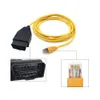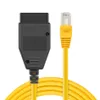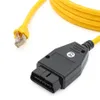The ENET Cable is a valuable tool for diagnosing BMW F-series vehicles. This cable enables faster and more accurate data transfer between the vehicle and the diagnostic software compared to other diagnostic tools. By using the ENET cable, users can save time and money by identifying and fixing problems quickly and accurately. Its features include easy installation, compatibility with various operating systems, and a durable design that withstands rough handling. This cable also provides access to advanced diagnostic features such as coding, programming, and module initialization. With the ENET cable, troubleshooting BMW F-series vehicles is fast and efficient, making it an ideal option for both professional technicians and DIY enthusiasts.








The ENET Cable
At its core, the ENET cable is a simple device that consists of a USB adapter on one end and an Ethernet port on the other. The cable is plugged into the car’s OBD-II port and connected to a computer using the USB adapter. Once connected, the computer can communicate with the car’s onboard computer, allowing technicians to read codes, perform tests, and diagnose problems.
One of the key features of the ENET cable is its compatibility with BMW’s ISTA diagnostic software. This software is specifically designed to work with BMW vehicles and provides detailed diagnostic information, allowing technicians to pinpoint problems quickly and accurately. The ENET cable is compatible with both ISTA-D (diagnosis) and ISTA-P (programming) versions of the software, making it an essential tool for anyone who works on BMWs.
Another key feature of the ENET cable is its ability to access hidden features in the car’s onboard computer. With the right software, the cable can be used to unlock advanced features like video playback while driving, automatic door locking, and more. These hidden features are not accessible through the car’s normal controls, and can only be accessed through the diagnostic system.
For enthusiasts and DIYers, the ENET cable is also a valuable tool for customizing their cars. With the right software and a bit of know-how, users can modify various settings in the car’s computer, such as adjusting the throttle response, disabling certain safety features, and more. This allows for a customized driving experience tailored to the owner’s preferences.
Fast and Accurate Data Transfer
Diagnostic tools have evolved from simple handheld scanners to complex computer systems that read and analyze data from various sensors and modules in the vehicle. The ENET cable is a critical component in this system, as it provides a high-speed connection between the vehicle and the diagnostic software.
The ENET cable uses Ethernet technology to transfer data between the vehicle and the computer. This technology is widely used in computer networks and provides fast, reliable, and secure data transfer. Compared to other diagnostic tools, which use slower and less reliable connections such as USB or Bluetooth, the ENET cable ensures that data is transferred quickly and accurately.
Another advantage of the ENET cable is its ability to handle large amounts of data. Modern vehicles generate vast amounts of data, which needs to be analyzed by the diagnostic software. The ENET cable can handle these large data sets without any loss or corruption of data, ensuring that the diagnosis is accurate.
Additionally, the ENET cable is easy to install and use. It simply plugs into the OBD-II port on the vehicle and connects to the computer via an Ethernet port. Once connected, the diagnostic software can quickly communicate with the vehicle and retrieve the necessary data for analysis.
Benefits of Using the ENET Cable
Firstly, let’s dive into what an ENET cable is. ENET stands for Ethernet, which is a type of wired connection used for local area networks (LANs). The ENET cable is a specific type of Ethernet cable that is used for connecting devices such as computers, gaming consoles, and routers to the internet. These cables are designed to transmit data at high speeds, ensuring a stable and fast internet connection.
Now that we know what an ENET cable is, let’s talk about its benefits. One of the advantages of using an ENET cable is that it saves you time in identifying and fixing connectivity issues. When using a wireless connection, there are several factors that can affect the signal strength and quality, such as distance from the router, interference from other electronic devices, and signal congestion. With an ENET cable, these factors are eliminated as the cable provides a direct connection between your device and the router. Therefore, if you experience any connectivity issues, it is easier to identify and fix the problem quickly and accurately.
Another benefit of using an ENET cable is that it can save you money in the long run. Wireless connections often require additional hardware such as boosters or repeaters to enhance the signal strength and quality. These devices can be expensive and may not always provide a stable connection. Using an ENET cable eliminates the need for additional hardware, saving you money in the long run.
In addition to saving you time and money, using an ENET cable also has other advantages. Firstly, it provides a more secure connection compared to wireless connections. Wireless signals can be intercepted by hackers, whereas an ENET cable provides a direct and secured connection. Secondly, ENET cables are more reliable compared to wireless connections. Wireless signals can be affected by environmental factors such as weather conditions, while ENET cables provide a consistent and reliable internet connection regardless of external factors.
In conclusion, using an ENET cable has several advantages over wireless connections. It saves you time and money by providing a more stable and reliable internet connection, eliminating the need for additional hardware, and providing a more secure connection. If you’re looking for a way to enhance your internet speed and reliability, investing in an ENET cable is definitely worth considering.
FAQ
Q: What is an ENET cable?
A: An ENET cable is a diagnostic tool used to transfer data between a BMW F-Series vehicle and a computer. It allows for faster and more accurate diagnostics, enabling users to pinpoint issues with their vehicle more efficiently.
Q: How does the ENET cable work?
A: The ENET cable connects to the OBD-II port on your BMW F-Series vehicle and then to your computer via USB. This connection allows for real-time data transfer, which can be used to diagnose and fix issues with your vehicle. The ENET cable also allows for coding and programming of various components within the vehicle.
Q: What are the benefits of using an ENET cable?
A: One of the main benefits of using an ENET cable is faster and more accurate diagnostics. This can save time and money by allowing repairs to be made quickly and efficiently. Additionally, the ENET cable allows for coding and programming of various components, which can enhance the performance and functionality of the vehicle. Finally, the ENET cable is easy to use and can be used by anyone with basic computer skills.
Q: Do I need any special software to use the ENET cable?
A: Yes, you will need specific software to use the ENET cable. There are several options available, including ISTA-D, ISTA-P, and E-SYS. These programs can be purchased or downloaded online and will allow you to communicate with your BMW F-Series vehicle using the ENET cable. It is important to note that some software may require additional licenses or expertise to use properly.